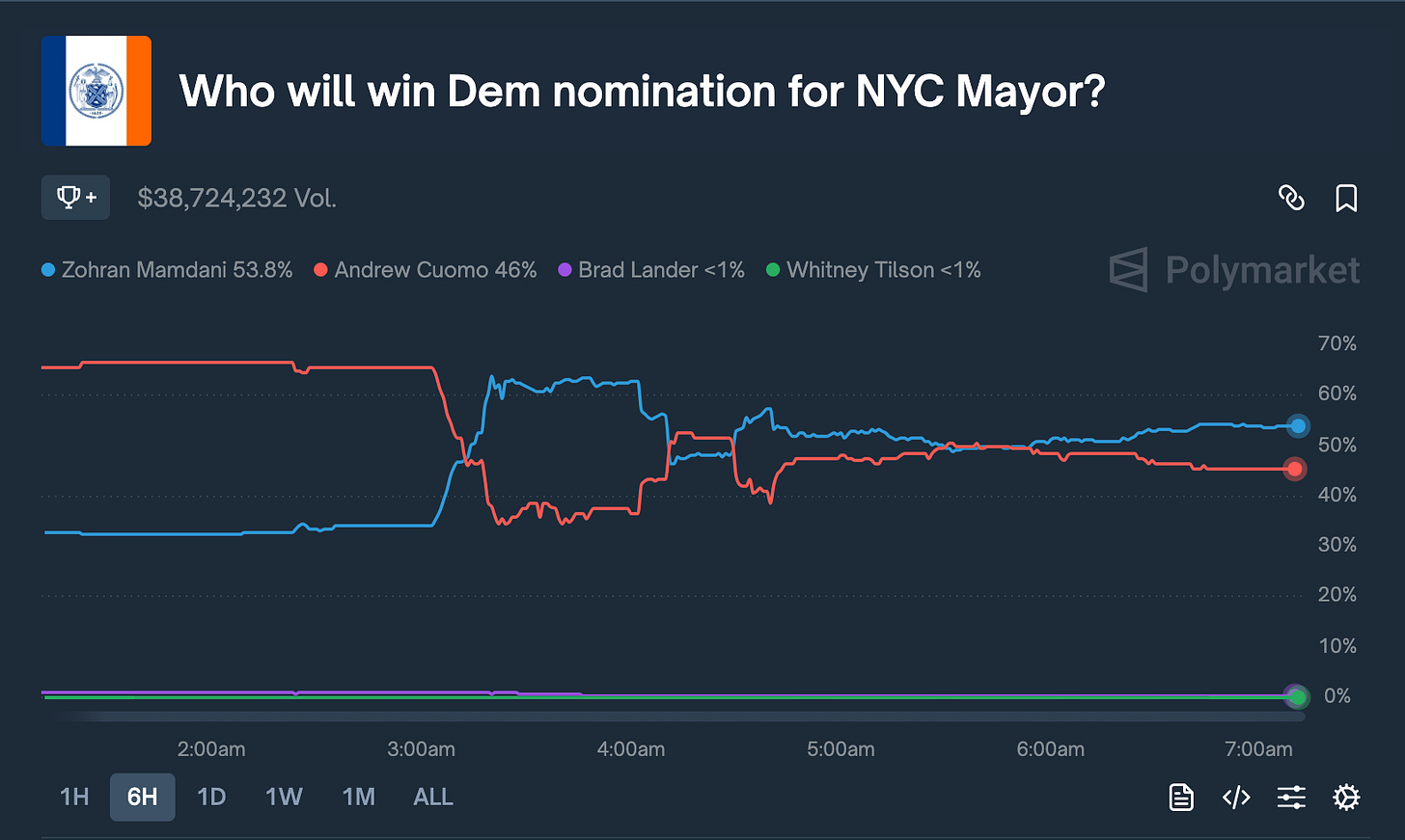'Prediction Markets Are More Accurate Than Polls' Will Be Tested In NYC Mayor Race
Odds at Kalshi and Polymarket shift dramatically towards Zohran Mamdani and away from Andrew Cuomo after new polls drop, instead of forecasting the shift.
How good are prediction markets at telling us who will win elections? We’re getting an interesting look at the concept in the New York City mayor’s race, where the primary elections take place tomorrow.
Kalshi and Polymarket now show the NYC Democratic primary as almost a dead heat between Zohran Mamdani and Andrew Cuomo. Both prediction markets had Cuomo as a 77-78% favorite yesterday, and greater than a 90% favorite in May.
Now, Mamdani is a slight favorite. Here’s a look at the graphs at both:
NYC uses ranked choice voting, where voters are allowed to vote for up to five candidates in order of preference. Most observers have made this a two-candidate race, however.
The most interesting thing to me is that these odds shifted because of the polls, not in advance of them. Both Kalshi and Polymarket like to portray themselves as more accurate polls, not something that moves because of the polls. Both platforms have claimed to be “the news, but faster,” in so many words. Kalshi and Polymarket took a bunch of victory laps for their odds favoring Donald Trump when he won the November presidential election. Polls, after all, had shown the race as a coin flip between him and Kamala Harris.
Nate Silver (a Polymarket adviser) seemed like he was more or less calling it yesterday on X/Twitter.
But here, polls moved first. Emerson College Polling dropped a new poll this morning, at about 9 am local time. More from Emerson:
The final Emerson College Polling/PIX11/The Hill survey of the New York City Democratic mayoral primary finds former Governor Andrew Cuomo leading with 35% support, followed closely by Assemblyman Zohran Mamdani at 32%, and Comptroller Brad Lander at 13%. … Since last month’s poll, Mamdani gained ten points on the initial ballot test, rising from 22% to 32%, while Cuomo gained one point, 34% to 35%.
The survey allowed voters to rank up to five candidates in order of preference. The ranked-choice voting simulation over eight rounds ends with Mamdani at 52% and Cuomo at 48%.
“Over five months, Mamdani’s support has surged from 1% to 32%, while Cuomo finishes near where he began,” said Spencer Kimball, executive director of Emerson College Polling. “In the ranked-choice simulation, Mamdani gains 18 points compared to Cuomo’s 12, putting him ahead in the final round for the first time in an Emerson poll.”
Odds at both markets had been tightening over the course of the past day, but Cuomo was still a 66% favorite until the poll dropped. The poll data came out, and money instantly started coming in on Mamdani. Here is a graph of the movement this morning at both markets (Kalshi only provides the past day on this market as of now):
Interestingly:
There was some movement toward Mamdani over the past week that accelerated (slightly) on Sunday, but the slope was pretty gentle.
There was some buyback on Cuomo after the poll at Polymarket, but the market seems to have settled on Mamdani.
Here’s Kalshi’s NYC mayor market, and here’s Polymarket.
Prediction markets offer a real-time look at probabilities, and they won’t always get the outcome right. And that’s a valuable function in the world! But here it’s hard to see prediction markets as anything but reacting to the news, not being ahead of it.
We’ll find out the results tomorrow and see how accurate polls and markets were, and how the prediction markets spin it.









